
They were everywhere! As Early as 1859 In Chicago they were a welcome refuge for Chicagoans coping with a hot summer. only to become less important with the advent of home air conditioning. In the 1920s there were more than 500 festive places in the Chicago area to escape the heat, eat, dance and drink. They were largely an old-world tradition brought to Chicago by German, Polish, and Irish immigrants.

Most summer gardens with names like Edelweiss, Germania, Heidelberg, Bismarck Gardens, or Rienzi.began by German-Americans. Wherever you went on a hot summer day you would find steins of beer, wine, music, dancing and a wide variety of activities.
Summer gardens were more commercial and elaborate, patterned after the old world European beer gardens. There you might find tables and chairs, food service, electric lighting, a stage, or even parking for your horse in a covered buggy shed. Some like Riverview evolved into amusement parks. and more. An orchestra of 12 to 20 pieces were common. Many but not all were on the north side catering to the German population. Back in the day newspapers describe the summer gardens as study of mosquitoes.
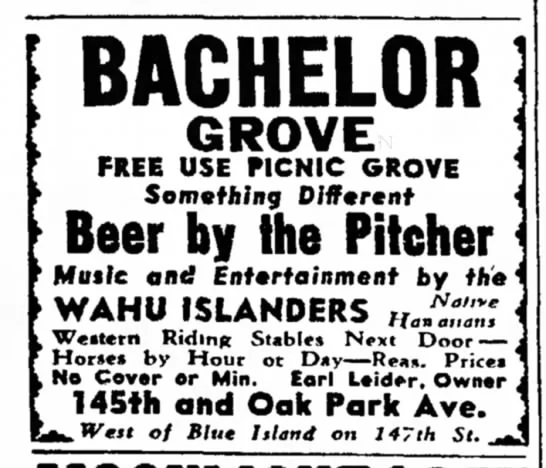
Although there was a fuzzy line between a picnic grove and a summer garden. picnic groves were more often a mom and pop operation. Many were simply behind a tavern with picnic benches and an outdoor bar. Larger ones could include a beer hall, dance pavilion, a bowling alley, rides or games.. They could be found just about anywhere there was a vacant piece of land. They could be found all over the city and it’s suburbs.
All was not perfect because summer gardens had to deal with noise, anti-German sentiment, labor strikes, and of course the prohibition act of 1919.

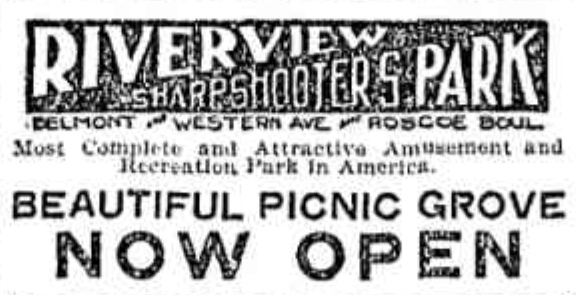
The most popular of course was Schutzen (Sharpshooters Park) which of course became the famous Riverview amusement park at Belmont and Western . There were two large picnic groves , refreshment stands and a ballroom . The groves could hold as many as 20,000 people in one day and were popular for organizations holding huge picnics and special events.
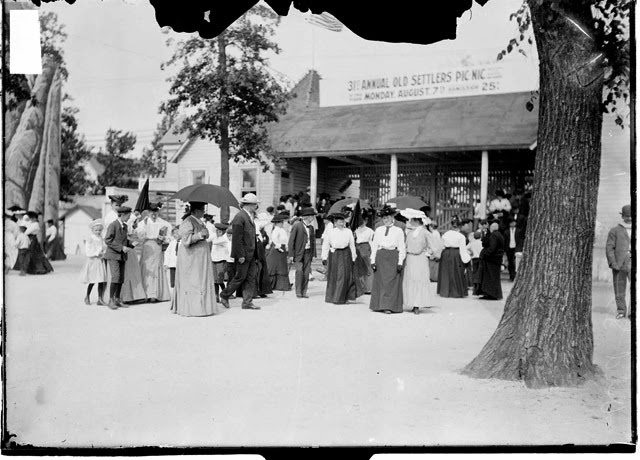
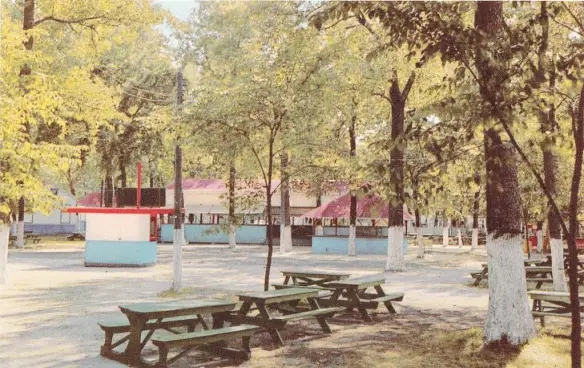
Other picnic groves were somewhat of a cousin to cemeteries but catering the mourners who made a long trip to bury their loved ones.
After a funeral and not wasting the rest of the day, there were picnic groves in close proximity to cemeteries where people could eat and drink and dance before the long buggy ride home.
And well after a funeral, death continued to be a constant visitor for many families, so family and friends would return to cemeteries often to “talk” and break bread with the deceased. Often it was simply a pleasant Sunday afternoon picnic among the tombstones remembering the deceased..
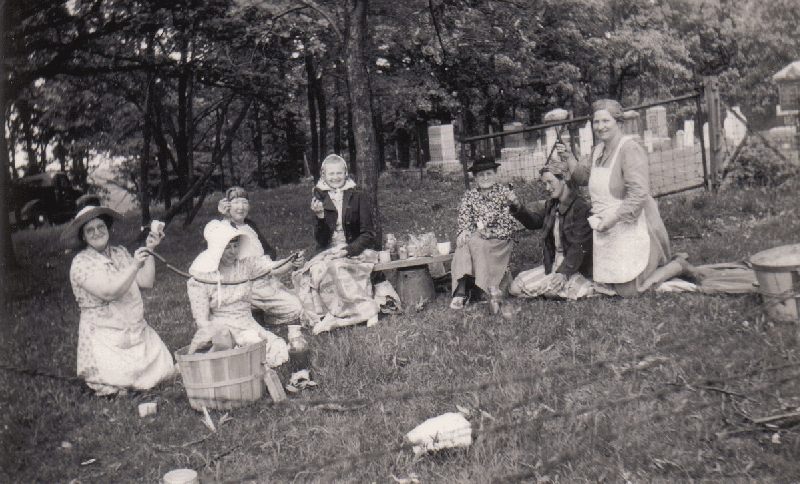
Read more as we visit many of them and learn of some of their oddities
There were four picnic groves on Chicago’s Northwest Side nearby to three cemeteries: Bohemian National, St Lucas, and Montrose cemeteries. These groves were all clustered together near the intersection of Crawford (once 40th street now Pulaski) and Foster 5200 north.

Scheiner’s Grove was located immediately south of Bohemian National Cemetery, on the east side of 40th Avenue, and straddled the north branch of the Chicago River. Present-day Foster Avenue forms what would have been the grove’s southern property line. There was a restaurant and beer hall facing 40th Avenue, from which visitors could walk to a foot bridge that led to the picnic grove on the other side of the river. Featuring a dancing pavilion, bowling alley, and beverage bars. Scheiner’s offered patrons offered complimentary parking for their horse-drawn carriages in the grove’s own buggy shed.

During its heyday in the 1900s and 1910s, Atlas Grove at 5125 n crawford, was the southernmost of three large picnic groves along the east side of North 40th Avenue (now Pulaski) Road). Atlas Grove was bounded roughly by Nagl’s Grove on the north, Springfield Avenue on the east, Argyle Avenue on the south, and 40th Avenue on the west. The Atlas Grove restaurant and tavern fronted 40th Avenue, behind which the picnic grove was located. The grove featured an outdoor dance floor, a bowling alley, a beverage bar, and access to a small pond.

Nagl’s Grove occupied a site on the east side of 40th Avenue, about 150 feet south of where 40th St. crossed the north branch of the Chicago River. The grove featured a restaurant and tavern, bowling alleys, two outdoor dancing pavilions, beverage bars, access to the river and a small pond, along with several game booths and other amusements. By 1913, the restaurant and tavern had been demolished, and the Bohemian Old People’s Home and Orphan Asylum was built on part of the site.
There were several other early summer gardens in the Chicago area
Circa 1859, the Sunday Gardens at Cottage Grove in the shadow of the University of Chicago, featured a dancing saloon, music stand, shed for selling beer and other liquors, shooting gallery, and drinking tables and seats. Reportedly attracting crowds by the tens of thousands. A court case against the garden cited “idle, drunken and disorderly persons” as well as noise, violence, drunkenness, and disturbing the peace.
One of the oldest on the north side was Ogden’s Grove, a beer garden and meeting ground, located near the north branch of the Chicago River at Willow Street near Clybourn Avenue,
Over 2000 attended on just one day in June 1887 paying $.25 admission. There was a merry-go-round, rifle gallery and plenty of beer and lemonade. A 50 ft.²dance floor for 200 couples.. There was a wheel of fortune game. A barker cried out “five balls for a dime, and a $.10 cigar every time you knock his head off”.

There was political speeches, German polka music, beer as well as genuine Neckar wine imported from the Royal cellars in Wurtenburg Germany, and for food you could have an onion pie called zwiebelkuchen and of course pretzels.
In 1896 7000 or more Wurtembergers gathered to celebrate the Schwaben Fest. At one end of the role there was a large open air stage erected the scenic background representing the river Neckar and a number of historic towns and castles on its banks
there were both German and Irish events held there. A detachment from the second Regiment band furnished dancing music in the large pavilion.
In 1895 And almost 20,000 Irish celebrated “Lady Day in Harvest at Ogden’s Grove. There were Irish jigs, athletic games a speaker’s platform. in attendance. The Bridgeport Grenadier’s 50 strong arrived at the ground in a bar completely covered in green. There was dancing and fireworks late into the night The last of the picnickers did not leave until after midnight.In 1890 at one event at Ogden’s Grove was an exhibition of a fruit piece 3 feet in diameter 40 feet high. Go figure.
Downtown there was was Kinsley’s woods in honor of the German who ran the place. It was a grove on the north side of Adams St., between Clark and Dearborn as late as circa 1894. What looked like a luxurious growth of grass was really just sawdust dyed a bright green. There was a middle stage, rows of Chinese lanterns, and a tall fountain. There were roundtables covered with red table cloths and china beer mugs.
Near downtown was Casino Gardens on Clark Street north of Kinzie from 1916
There were at least four picnic groves in the immediate vicinity of Riverview and the predominantly German-American Lakeview neighborhood:

Harms Park Picnic Grove, located on the northeast corner of Western and Berteau Avenues. (4200 north) less than 10 blocks north from and predated Riverview. The land owner Henry Harms 1832-1914, started the park in 1883. He is best known as the founder of the village of Niles Center (Skokie). Harms Road and Harms Woods are also named after him.

Belmont Grove was one of several small outdoor beer gardens that operated in Chicago’s during the 1890s on the northeast corner of Belmont and Western Avenues, and extended as far north as Melrose Avenue. The garden featured a dancing pavilion, open bar, and a bowling alley. It had ceased operations by the early 1920s. The property, however, remained largely undeveloped in 1923, except for a few stores, a meeting hall, and a storage shed.
Millers Garden. It occupied the northeast corner of Belmont and Leavitt Avenues and opened no later than 1880 The garden included a dance hall and a small outdoor dancing pavilion. By 1923, Millers Garden had closed and been replaced by residences.
Little is known at the moment about the Ph. Hollinger’s Oak Grove on the northeast corner of Belmont and Sheffield
Paradise Garden consisted of little more than a dancing pavilion and a patch of open ground, on the northeast corner of Melrose and Oakley Avenues. The garden opened no later than 1882 and closed by the early 1920s, replaced by residences. (There was actually another Paradise Garden circa 1924 farther northwith the same name) it was located at 5141 Robey St. (renamed Damen) the southeast corner of Damen and Foster
De Berg’s Grove which later became Bismarck Gardens the intersection of Halsted , Grace, and Evanston Avenue (now Broadway)
A bit farther west from Riverview we find:

Electric park amusement association opened august 3 1895 at the intersection of Belmont, Elston, and California 50 acres with 100 electric arc lights offering bicycle races, baseball, football, dancing in the grand temple of music, fireworks, a lagoon and Alpine railway. It featured four gondolas from the world’s fair. You could feast on ox roast. It was originally lit by calcium lights fueled by oxygen and hydrogen and later 100 arc lights. There was a terrible fire on July 15, 1898. 32 dressing rooms and 300 costumes were lost .

Brands Park 3250 Elston, Originally a tavern and dancing pavilion but over time, several rides and attractions were added and by 1913, there was a merry-go-round, a bowling alley, a shooting gallery, a photo booth, game booths, a beer hall, several free-standing bars, steel-truss-roofed dancing pavilion and a restaurant with a canvas-covered seating area. The park closed in 1927, when the Chicago River Park District, a predecessor to the Chicago Park District, purchased and redeveloped the site.
There was the Green Mill Sunken Gardens opened 1914 at4802 North Broadway. Originally called Pop’s Morse Gardens . It later became the Moulin Rouge in 1917 and then Rainbo Garden circa 1921

the Cascade Gardens and ballroom Sheridan and Argyle circ 1920’s and the Broadway Gardens

One of the largest was Bismarck Gardens


The largest and most popular summer garden on the north side was the Bismarck Gardens was located at the southwest corner of Grace and Halsted Streets in Chicago’s Lakeview neighborhood. It was originally De Berg’s Grove but was purchased in 1895 by Carl Eitel, president of the Bismarck Hotel and with his brother Emil . He renamed the property to serve the German-Americans living on Chicago’s North Side. It featured seating for 2600 ample shade trees, electric lamps, an outdoor stage and dance floor, and plenty of German beer and music. The indoor marigold room allowed for year-round operations. Mission for a time is $.25 after 7 PM but free during the day.
There was a fire in June 1913 destroyed the bandstand, the silver pantry, musical instruments, locker rooms and the West kitchen.
Bismarck Gardens sometimes advertised as the Bismarck Wintergarden and its elegant Marigold room restaurant was renamed Marigold Gardens in 1915, in response to rising anti-German sentiment in the city during the First World War. Closed in December of 1923 because of prohibition. The owners leased the property to Al Mann who opened Vanity Fair, in 1935. It was called Chicago’s Café of distinction with its 4 floor shows nightly..
Marigold Gardens laterbecame Marigold Arena because of the popular boxing and wrestling matches. The elegant gardens property was finally sold in 1951 and turned into a parking lot, however parts of the former Marigold Gardens dance hall complex still stand, converted to other uses.
In May of 1917 the Moulin Rouge opened at Clark and Lawrence with a 40 piece band and three dance floors. They held key dances every afternoon. 30 colored electric fountains scattered among the tables. Manager Albert Boucher was the former chef of the Moulin Rouge in Paris. A few years later it became the Rainbo Garden.


There were many more North Side venues including Robert Wosslick’s Kaiser Garten on the northeast corner of Halsted and Addison.
Along Clark Street were the Sheridan Drive club at Wilson Avenue, Sunnyside Park, Biewers garden on Lawrence Avenue, Manilla Grove, Gunther summer garden at the corner of N. Clark St. at Leland, and Simon’s Grove on Leland Avenue, and Shadyside Park
On the Northwest side was several more picnic groves and summer gardens the most popular was Kolze’s Electric Park

Henry James Kolze was born June 23 1859 in Leyden Township, and married Katherine Guthier. Starting out in 1884 they built a house and restaurant at 9300 W. Irving Park and called it the Colonial Inn including a rather small picnic ground.

He was so well known in the area that the nearby Soo Line railroad station was named Kolze Station until it was finally renamed in 1924.
By 1901 he had bought land at 6353 Irving Park located just east of Northwest 64th Street (now Narragansett Avenue). There he built a new hotel, clapboard tavern, restaurant and several other buildings. The large amount of wooded area behind those buildings became his new Kolze’s Electric Park (also sometimes called Kolze’s Grove). The street car line had recently been extended on Irving Park in 1896 and Henry’s park was conveniently on the end of the line. Electric parks and amusement parks were often located at the end of trolley lines to bolster weekend travel and therefore revenue. His park was also in the shadow of the Cook County Poor House and insane asylum .
Henry did well. Opened to the general public who happily entered through grand arches. As well as church groups, labor unions, political organizations, military groups, and large family functions all who could rent the entire park..
By 1905, Kolze’s boasted many buildings, a dance pavilion, shooting gallery, picnic tables, refreshments, , concession stands, and plenty of German beer, Attendance at the park steadily increased during the 1910s and 1920s, leading Henry to undertake additional expansion of the park. By 1924, several new booths and refreshment stands had been added. And there were plenty bright electric lights, hence the name “Electric Park”.
Henry had first strung large gas lamps to offer illumination to a nightly orchestra, At the beginning of the 20th century, many places continued to be illuminated with this dangerous gas lighting. Henry soon converted the park to electric light which meant that guests could drink and dance well into the evening enjoying music and cooler air.

Henry James Kolze Sr., who was also a county commissioner in 1904, died on June 11 1926 in Ravenswood Hospital of pneumonia and was buried in Ridgewood Cemetery on Milwaukee Avenue .
His son Henry James Kolze Jr 1891-1982 carried on, operating the Kolze Electric Park until it closed
In 1947, the Chicago Park District acquired the property and would convert the picnic grove into a public park. The park district demolished 19 of 20 buildings on the site, except the original clapboard tavern which served as the park’s new field house until it too was replaced in 1969. The new park became today’s Merrimac Park.
Maple Grove were located across the street from Kolze’s Grove on the southwest corner of Irving Park Road and Narragansett Avenue. Both were much smaller than Kolze’s Grove but Elm Tree Grove did have bowling lanes

Elm Tree Grove was located at the southwest corner of Irving Park Boulevard and Neenah Avenue in the Dunning section of Chicago. In 1905, the picnic grove included a dancing pavilion, restaurant, and small bowling alley, all of which remained in place until at least 1924. The picnic grove was bordered on the south by Mount Olive Cemetery and on the north by the Cook County Mental Hospital.

Ther was Excelsior Park on Irving Park Road between Drake and Central Park Avenue with a dance hall, there were “doll baby”, “Cane,” and “knife” games. It burned down July 1908 on Irving Park. A.J. Smith was the proprietor, and it was suspected that electrical wiring the caused fire. The loss was estimated at $50,000.

Frank Thielmann’s Palm Gardens originally built as Fischer’ s Gardens opened 1890 on the north end of Lincoln Park at the foot of Diversey Avenue. Circa June 1898. Fire destroyed the garden in February 1900. Nothing was left except the bicycle entrance, a covered gateway, with an estimated loss of $20,000. Several thousand people watched the destruction of the garden.

Rienza garden and Café the northeast corner of Diversey and Broadway. During the Civil War the area was known as Camp Fry a Confederate prisoner of war camp. Circa 1860, it was originally known as Wrights picnic Grove. Rienzi then opened between 1901 to at least 1916 and then transitioned to the Hotel Rienza. At 600 Diversey Pkwy.
The Pilsener Summer Garden occupied a roughly triangular piece of land between Montrose, Elston, and North 40th (later Pulaski) Avenues in the old Irving Park neighborhood .In 1905, the resort featured a dancing pavilion, bowling alley, and at least two refeshment bars. By 1924, however, Pilsener’s had given way to urban growth, replaced by a filling station and new commercial storefronts along the increasingly busy Elston and Montrose Avenues.
In the west suburbs, there was the popular Louisenhain Grove circa 1887 and 1896 located adjacent to the German old peoples home Altenheim station in Forest Park featuring music , dancing, games, races and speechestrains on the Wisconsin Central Railroad from their depot corner Oak Street and Fifth Avenue directly to the entrance of the park stopping all principal Street crossings to the West division the price of a round-trip ticket in 1887 is $.50. Trains of the Dummy Road, connecting with the W. Madison St. cars, may also be used. They start every 40 minutes at W. 40th St. for Alton I. The Northwestern Railroad runs trains to River Forest, from which it is but a short distance over a can the pathway to the park. Guests without round-trip tickets which are good only on the Wisconsin Central have to pay $.25 each for a mission to the park.
The 1890 mid-summer Festival was called Volksfest or picnic. Several special trains were run besides the regular trains. All of them were crowded. There was the red tape committee which took up the tickets of passengers and gave them small slips of red tape Alton I’m printed on them to be pinned to the lapel of one’s coat or dress. Everybody at the park wore one of these except the babies in.. Babies were placed in hand mocks while the mothers ate dinner.
There were races, with an unusual array of prizes including pretzels, baseballs, lives geese, scrapbooks, baths, coffee grinders, picture books, two watermelons, comic papers, pieces of cake, jet knives, ropes, and sausages. The older people indulged in all sorts of contests including shouting matches bowling matches political contests and popularity testers. There was a small tent called a “Stimmkessel” also known as a “voting kettle” for the most popular prohibitionist prize was a mug to drink out of.
Another feature of the day was the old-time wedding procession although no one was married it was intended to be a cheerful reminder of the old-time Fatherland wedding processions with the bride and groom road through the village. They were followed by wagons and animals bearing sufficient presence to last a lifetime and enough food to keep the bride and groom from toiling during the first month of their wedded bliss. It was first led by a courier in an old-time cost to followed by a brass band, followed by children very long poles from which were suspended several hundred pretzels and sausage. The sausages were followed by bridesmaids and groomsmen and then came hosts and guests bringing with them presence without number including a pretty bedstead, , an ox headed horse is a joke, several donkeys, horses, geese, goats, and cows. The bride received a bracelet and the groom received a metal as souvenir
all of this is July 28, 1890.
Reissig park in riverside circa 1896. A Bicycle race from Lagrange to the picnic grounds a distance of 7 ½ miles was a feature of the afternoon. Prizes included everything from a box of cigars to a silver watch given to the winners.
There were many many groves in the North suburbs, and I will only list a few of them

L.M. Schufreider picnic grove and pavilion Milwaukee Avenue 1 mile south of Des Plaines River bridge at Lake Street. For rent or private picnics. refreshment parlor September 1921 grand opening May 8, 1921 tickets gentlemen $.68 plus tax ladies $.22 plus tax. “Good order will be maintained. All improper dances prohibited. Refreshments served.”
Niles Center picnic Grove Oakton and Lincoln Avenue. There was William G Meyer known as stubby who ran Stubby’s picnic Grove and pavilion 40 to 50 years on the Meyer homestead in Arlington Heights and there was the Forest Hill picnic Grove on Higgins one a half miles west of Arlington Heights Road circa 1942

Klehm’s Grove in Niles Center remodeled in 1925 by Charlie landerer , Tessvile inn Lincoln and Touhy dance hall and picnic Grove dancing every Sunday proprietor Tom bodkin

Viani’s Picnic grove park ridge Talcott Road route 62, 1 mile west of Cumberland Maine Township Tavern and restaurant established 30 years from 1950

Forest Hill picnic Grove on Higgins Road ½ mile west of Arlington Heights Road, Greenview picnic grove opened June 1925 on River Road one block south of Higgins road, Schnell’s Maple Grove and pavilion in elk Grove Village frank busse mgrCirca 1922
Several picnic groves served the Polish community. Here are just two:
Polonia Grove, located at Higgins and McVickers Avenues. (60th avenue )

Polonia Grove 4604 s archer had a picnic area about 60% of a city block. The grove was along Drake Ave.on the north side of Archer and the hall was on the corner of the next street east, great for picnics and Polish weddings. There were tall Cottonwood trees and circular
benches built around them in addition to the regular picnic tables. there was an
outside bar and a dance area and bandstand.
On Chicago’s south side and in the southern suburbs there were:
Oswald Grove 52nd and Halsted owned by Joseph Oswald who died about August 1898
Casino Gardens at 95th and California Joseph a Lewis part owner he was murdered in July 1929. His wife testified competition in the roadhouse racket may have been the cause of his death
Dreamland Gardens and ballroom 3518 – 20 S. State Street until 1928 then 4700 S. state between 1933 and 1946


Midway dancing Gardens on Cottage Grove opened June 27, 1914. Located at the head of the Midway and opposite Washington Park . The main garden is really a series of three terraces defined by railings transformed into flower boxes. music by the national Symphony orchestra and the Midway Gardens orchestra. An atmosphere similar to the gardens in Europe.

Midway Gardens became Edelweiss 5052 Cottage Grove . Along with the Peter Schoenhofen brewing company they were sued for $50,000 by a neighbor George K Wentworth the suit stated quality of the music and the nature of the illumination large crowds people engaged in drinking wine spears and liquors, loud and discordant sounds and noises from musical instruments until late hours at night during the daytime including Sundays and often until after 12 midnight. A vulgar and dazzling illumination by means of electric lights so as to be a nuisance to the neighborhood.
There was the Lincoln Gardens /Royal Gardens 459 E. 31st St., the Heidelberg 884 E. 51st St.once operated by the Keeley brewing company the
Germania at 801 west 51st street circa 1902, the Flora 5040 Cottage Grove, Marion Goch’s picnic Grove circa 1948 at 3234 E. 92nd, ,
Olympia Gardens picnic Grove on 211th between Western Kedzie circa 1951 one block from the Matteson station of the Illinois Central Railroad,
Kowalski’s Grove 1017 Burnham Ave. in Calumet city circa 1938, SAG Ridge picnic Grove Archer Avenue and 107th st games music and dancing,
Vollbrecht grove 167th St. and stony Island circa 1938, Royal Oaks picnic Park 87th St. one block west of Kean Avenue in Justice Park Illinois, and Mike’s picnic Grove 126 and Avenue O,
There was Frank’s Grove near Douglas Park circa 1931 – 1941, Paynes Groves Torrence Avenue 154th St., Eggers Grove, and Wozniak’s casino on Blue Island Avenue
Sunset Park Archer Avenue near 135th St. was a large picnic Grove enclosed dance hall barroom popular in the winter as well as the summer five room home combination garage and barn only 10 years old in 1939 the farm covers 30 acres in the picnic grove and trees covers 28 fronts 1500 feet in Archer Avenue and 1500 feet on 135th
Pilsen Summer Garden
During the early twentieth century, the Pilsen Brewing Company operated a summer beer garden, at 3101 West 26th Street, next to their brewery at 3045-3057 West 26th Street. It included a dance hall, banquet hall, and outdoor beverage bars.
As popular as summer gardens were, some neighbors, politicians, and temperance groups tried to shut many of them down. Around 1900 Mayor Harrison was very hostile to Germans, German institutions, summer gardens and the brewery interests and tried hard to shut down by denying them a liquor license.. The anti-saloon league objected to the beer flowing. Neighborhood groups like the Citizens of Ravenswood were opposed to Sunday beer and complained of late-night crowds and blaring of Sousa marches and ragtime melodies. More than one bitter fight to eliminate summer gardens made it all the way to the Illinois Supreme Court but largely failed.

Many summer garden and picnic groves became less relevant, went out of business because of complaints, prohibition, or death of the owner. Others suffered financial ruin or burned down. Only a very few survived, some replaced by forest preserves and the park district.
There is no doubt that they were great places for entertainment, drinking, and dancing. But as home air conditioning became common, there was less of a need to beat the heat outdoors. The first home window air conditioning units were manufactured and sold in 1931. These retail for between $10,000 and $50,000, making them available only to the truly wealthy. My dad bought a Fedders air conditioner in 1954 for about $200.

If you have fond memories of any summer garden or picnic Grove in the Chicago area or something I missed, please add your comments below
Thanks for the interesting historical story about the gardens and parks in the Chicago area. I especially liked knowing how people transitioned from the outdoors to the indoors with the introduction of air conditioning. So many things to think about after reading your article.
LikeLike